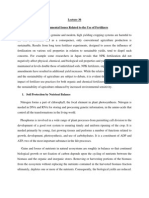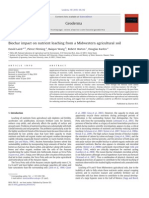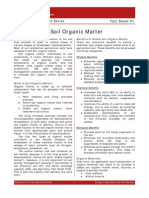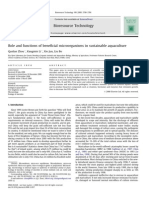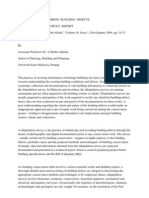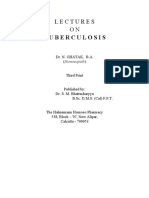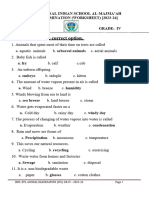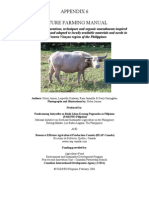Soil Fertility Management For Organic Crops: Vegetable Research and Information Center
Soil Fertility Management For Organic Crops: Vegetable Research and Information Center
Uploaded by
mastergeo35Copyright:
Available Formats
Soil Fertility Management For Organic Crops: Vegetable Research and Information Center
Soil Fertility Management For Organic Crops: Vegetable Research and Information Center
Uploaded by
mastergeo35Original Title
Copyright
Available Formats
Share this document
Did you find this document useful?
Is this content inappropriate?
Copyright:
Available Formats
Soil Fertility Management For Organic Crops: Vegetable Research and Information Center
Soil Fertility Management For Organic Crops: Vegetable Research and Information Center
Uploaded by
mastergeo35Copyright:
Available Formats
UNIVERSITY OF CALIFORNIA
Division of Agriculture and Natural Resources
http://anrcatalog.ucdavis.edu
Publication 7249
SOIL FERTILITY MANAGEMENT
FOR ORGANIC CROPS
MARK GASKELL, UC Cooperative Extension Farm Advisor, Santa
Barbara and San Luis Obispo Counties; RICHARD SMITH, UCCE Farm
Advisor, Monterey and Santa Cruz Counties; JEFF MITCHELL, UCCE
Vegetable Crops Specialist, Kearney Agricultural Center, Parlier; STEVEN
T. KOIKE, UCCE Farm Advisor, Monterey and Santa Cruz Counties;
CALVIN FOUCHE, UCCE Farm Advisor, San Joaquin County; TIM
HARTZ, UCCE Vegetable Crops Specialist, UC Davis; WILLIAM HOR-
WATH, Professor of Soils and Biogeochemistry, UC Davis; and LOUISE
JACKSON, UCCE Vegetable Crops Specialist, UC Davis.
Growers need sound information to guide their
management decisions on organic vegetable pro-
duction practices in California, yet pecific informa-
tion is scarce. The Organic Vegetable Production in
California Series consists of publications written by
farm advisors and specialists from the University
of Californias Division of Agriculture and Natural
Resources. Each publication addresses a key aspect
of organic production practices applicable to all veg-
etable crops.
Organic soil fertility management is guided by the
philosophy of feed the soil to feed the plant. This
basic precept is implemented through a series of prac-
tices designed to increase soil organic matter, biologi-
cal activity, and nutrient availability. For the current
list of approved practices for organic certification,
see the USDA National Organic Program (NOP) Web
site at http://www.ams.usda.gov/nop/indexIE.htm.
Adding organic materials such as cover crops, crop
residues, and composts to cultivated soils over time
builds soil organic matter and improves the ability
of the soil to supply nutrients. The ultimate goal is a
healthy, fertile, biologically active soil with improved
structure and enhanced nutrient availability. Organic
management practices strive to optimize diverse bio-
logical processes in the soil to create a complex envi-
ronment that ensures adequate nutrition to the crop.
For a discussion of related soil management practices,
see Soil Management and Soil Quality for Organic Crops
(UC ANR Publication 7248, http://anrcatalog.ucdavis.
edu/pdf/7248.pdf).
ROLE OF ORGANIC MATTER
AND HUMUS
Increasing soil organic matter is a key aspect of
an organic production system. The formation and
decomposition of soil organic matter are fundamental
life-promoting processes that store and release energy
derived from photosynthesis. Soil organic matter is
mainly the product of microbial and faunal decompo-
sition of plant residues. The decomposition of plant
residue leads to the formation of humic substances,
which constitute 70 to 80 percent of the organic mat-
ter in most soils. The remaining soil organic matter is
termed light fraction or particulate organic matter
and is composed of a continuum of material ranging
from recently deposited litter to highly decomposed
unrecognizable plant residues. Soils with higher clay
contents in temperate climates generally have the
most soil organic matter. In California, organic matter
typically makes up 1 to 3 percent of the dry weight
of cultivated agricultural soils and 4 to 6 percent of
untilled pasture soils. Studies have shown that it is
normally not possible to increase soil organic matter
by more than 1 percent, but even an increase of this
much can dramatically improve soil fertility.
During the formation of soil organic matter, nutri-
ents such as nitrogen (N), phosphorus (P), and sulfur
(S) are incorporated into the soil structure, allowing
the soil to act as a reservoir of these and other nutri-
ents. The decomposition of soil organic matter releas-
es nutrients, at which point they become available for
plant uptake. Generally, 2 to 5 percent of soil organic
matter decomposes annually. Soil organic matter
VEGETABLE
RESEARCH AND
INFORMATION
CENTER
Organic
Vegetable
Production in
California
Series
Specific information on organic vegetable production practices in California is scarce, and growers need sound information
to guide their management decisions. The Organic Vegetable Production in California Series is made up of publications
written by Farm Advisors and Specialists from the University of California's Division of Agriculture and Natural
Resources. Each publication addresses a key aspect of organic production practices applicable to all vegetable crops.
WWW.SFC.UCDAVIS.EDU VRIC.UCDAVIS.EDU
contains a number of fractions that vary in composi-
tion and activity. Humus is the most resistant and
mature fraction of soil organic matter. It is very slow
to decompose and may last for hundreds of years.
Plant residues that are high in carbon (C) and low
in nitrogen, such as straw or cornstalks, decompose
slowly but are efficient producers of humus. Residues
that contain high levels of nitrogen, such as young
cereals and legumes, decompose quickly, producing
less humus. Although the process of organic mat-
ter formation is not well understood, it is clear that
increasing the amount of soil humus improves soil
properties and crop growth.
The decomposition of organic matter in soils can
provide significant quantities of several important
nutrients. A portion of the nitrogen from organic
matter is converted into plant-available mineral
forms such as ammonium (NH4
+
) and nitrate (NO3
)
through the process of mineralization. However,
the timing and amount of mineralization often do
not coincide with crop need, making in-season fer-
tilization necessary. This lack of synchrony between
nitrogen mineralized from organic matter and crop
nitrogen uptake is a major challenge for fertility man-
agement in organic systems. Organic matter is a good
source of phosphorus; as phosphorus is mineralized
from organic matter it becomes available for plant
growth or becomes bound to soil minerals. Organic
matter is also a significant source of micronutrients
such as iron (FE), copper (Cu) and zinc (Zn).
In addition to supplying nutrients, soil organic
matter improves soil fertility by imparting favorable
chemical and physical attributes to soil. Soil organic
matter can bind nutrients through the process of
cation exchange. Ammonium (NH4
+
), calcium (Ca),
magnesium (Mg), and potassium (K) are nutrient cat-
ions that are held on cation exchange sites on organic
matter. The cation exchange capacity of soil organic
matter can contribute from 20 to 70 percent of the
total cation exchange capacity of soil. Soil structure
is influenced by the association of soil organic matter
with minerals to form aggregates. Aggregate forma-
tion improves soil structure and water infiltration
and increases water-holding water capacity. These
changes improve root growth and provide habitat
for a diversity of soil organisms. Soil organic mat-
ter enhances nutrient cycling, provides habitat for a
diversity of soil organisms, and creates a favorable
environment for plant growth.
HOW TO DETERMINE NUTRIENT NEEDS
Crop nutrient requirements and the nutrient-supplying
capacity of the soil dictate the management practices
necessary for successful crop production. Soil testing is
essential for the assessment of nutrient levels, and it is
often required for organic certification. Management of
nutrients such as phosphorus, potassium, calcium,
magnesium, and sulfur should be directed toward rais-
ing these nutrients to optimal levels in the soil as deter-
mined by soil testing. Phosphorus availability in soils
with pH greater than 6.0 is assessed by the Olsen bicar-
bonate test; for soils with pH less than 6.0 the Bray test
is used. In most vegetable production areas in California
soil pH is greater than 6.0, so this discussion will focus
on the Olsen bicarbonate soil test. Natural levels of
phosphorus in most California soils were formerly less
than 30 ppm. Over years of fertilization for commercial
vegetable production, fields now routinely have soil
phosphorus greater than 60 ppm along the coast, and
somewhat less in the interior valleys. Phosphorus avail-
ability is reduced at low soil temperatures (i.e., < 60
o
F,
or 15.6C) and, as a result, crops grown in the cooler
part of the year need higher levels of available soil phos-
phorus for good growth. Approximate soil adequacy
values from the bicarbonate phosphorus test for warm-
and cool-season vegetables are given in table 1.
Table 1. Adequate soil phosphorus levels
(bicarbonate phosphorus test)
Crop
Adequate soil
P level (ppm)
warm-season vegetables 2025
cool-season vegetables 5060
Compost and certain organic fertilizers are good sources
of phosphorus. It is important to monitor soil phos-
phorus levels on a yearly basis, as soil phosphorus
can rapidly build up high to levels when composts
and other organic amendments are used. Excessive soil
phosphorus can result in high phosphorus concentra-
tion in field runoff, which can impair the quality of
surface waters such as rivers, creeks, and lakes.
Soil potassium level is best determined by an
ammonium acetate extraction test. In general, if soil
potassium is greater than 200 ppm, no increase in
yield is likely to be obtained with additional potas-
sium fertilization. However, maintenance applica-
tions of potassium may be helpful in replacing soil
potassium that is removed in the crop. For soils at
less than 150 ppm potassium, fertilization is warrant-
ed. Composts and some organic fertilizers are good
sources of potassium.
Calcium, magnesium, and sulfur are usually pres-
ent in the soil and in irrigation water in sufficient
quantities to adequately supply a crop. In very sandy
soils with low levels of organic matter, sulfur avail-
ability may be limited, but normal organic practices
(application of compost, use of sulfur as a fungi-
cide) typically maintain adequate levels of soil sulfur.
While neither calcium nor magnesium availability is
2 Organic Certification, Farm Planning, Management, and Marketing
often limiting for crop nutrition, in some fields rela-
tively low soil calcium and/or high magnesium con-
tent can result in poor soil structure and slow water
infiltration. In these circumstances application of gyp-
sum (naturally occurring calcium sulfate) is the most
appropriate remedy.
In organic systems, appropriate nitrogen man-
agement cannot be directly inferred from a simple
soil test. Unlike conventional production, in which
nitrogen management is based on the use of soluble,
readily available nitrogen fertilizers, in organic sys-
tems nitrogen management is based on manipulating
organic sources of nitrogen; organic nitrogen must be
mineralized through the action of soil microbes before
it is available for plant uptake. Although this process
can supply a significant quantity of nitrogen, estimat-
ing the amount and timing of nitrogen mineralization
is complicated because a number of factors affect the
process. The most important of these factors are as
follows.
Soil temperature: Mineralization is insignifcant
below 50F (10C), but above that temperature,
mineralization increases as soil temperature
increases.
Soil moisture: Mineralization proceeds rapidly in
moist soils, but is inhibited by either excessively
wet or dry conditions.
Tillage practices: Soil tillage stimulates a
temporary burst of microbial activity, which
declines over the course of days or weeks.
Despite the complex interactions of these factors, a
rough estimate of mineralization from soil organic
matter can be made based on the amount of organic
nitrogen present in the soil and the percentage of that
nitrogen likely to mineralize over a given period of
time. The following procedure describes a method for
estimating the amount of nitrogen likely to be mineral-
ized from soil organic matter.
The first step is to estimate the amount of organic
nitrogen in the soil. This can be done directly by a spe-
cialized laboratory test, or it can be inferred from the soil
organic matter content. In most agricultural soils, organ-
ic nitrogen constitutes approximately 7 percent of soil
organic matter. The vast majority of nitrogen mineraliza-
tion takes place in the top 1 foot (30 cm) of soil. A stan-
dard estimate of soil weight is 4,000,000 pounds of dry
soil per acre-foot (about 1,816,000 kg /100 cubic meters).
The organic nitrogen content of a soil with 1 percent
organic matter would be
4,000,000 lb soil 0.01 (percent organic matter)
0.07 (percent N in organic matter) = 2,800 lb organic
N/acre (3,136 kg/ha)
The second step is to estimate the percentage of
soil organic nitrogen likely to mineralize during the
crop cycle. Laboratory incubation studies of dozens
of California soils have shown that, at best, about 2
percent of soil organic nitrogen is mineralized in a
2-month period at 77F (25C). For a soil with 1 per-
cent organic matter, that would be
2,800 lb organic N/acre 0.02 (percent of organic
nitrogen that mineralizes) = 56 lb plant-available
N/acre (63 kg/ha)
The 2 percent estimate for nitrogen availability for a
short-term annual crop can be adjusted to fit field-spe-
cific conditions based on the factors previously
described. Fields that are sprinkler-irrigated keep the
entire soil surface moist, while much of the surface soil
in drip-irrigated fields may be very dry. The soil tem-
perature during spring and fall crops is lower than that
for summer crops. Fields in which any form of reduced
tillage is practiced tend to have slower nitrogen miner-
alization. Heavy clay soil is more readily waterlogged
by rain or irrigation, and effective nitrogen mineraliza-
tion may be reduced. Note that this technique for esti-
mating nitrogen mineralization from soil organic matter
does not take into account the nitrogen contribution
from recently incorporated crop residue, compost, or
other organic amendments. These contributions are
described elsewhere in this publication.
Synchronizing nitrogen mineralization from soil
organic matter, cover crop residues, and organic
amendments to maintain adequate nitrogen availability
for crop production is challenging. The generalized
pattern of nitrogen mineralization and crop nitrogen
uptake is presented in figure 1. The rate of nitrogen
mineralization from soil organic matter and recently
incorporated residues and amendments typically peaks
before the crop reaches its maximum rate of nitrogen
uptake. Even in organic systems, nitrogen loss through
leaching or denitrification (conversion of nitrate to gas-
eous nitrogen in wet soil and subsequent loss to the
atmosphere) can be substantial if excessive water from
rain or irrigation is applied to the field in the early
weeks of the growing season.
Short-season crops with low nitrogen requirements
such as leafy greens and radishes (table 2) may pro-
duce well with the nitrogen available from soil organ-
ic matter plus cover crop residues and/or a compost
application. Crops with higher nitrogen requirements
and longer growing seasons often need supplemental
sidedress applications of organic nitrogen fertilizer.
For many vegetable crops, quality is as important as
yield. Product size, color, and uniformity can be criti-
cal, and nitrogen management is often the key to
maximizing these quality attributes.
3 Organic Certification, Farm Planning, Management, and Marketing
Low total N content
< 120 lb/acre
Medium total N content
120200 lb/acre
High total N content
> 200 lb/acre
baby greens carrot broccoli
beans corn, sweet cabbage
cucumbers garlic caulifower
radish lettuce celery
spinach melons potato
squashes onion
peppers
tomatoes
Figure 1. Timing of nitrogen mineralization from
soil organic matter, cover crop residue, and organic
fertilizer in relation to crop nitrogen uptake.
NUTRIENT SOURCES
Cover Crops
Cover crops fix and trap nutrients, add organic matter
to soils, and reduce nitrate leaching, nutrient runoff,
and soil erosion. In California, cover crops are widely
used in organic farming systems because the climate is
mild enough to support growth during the fall, winter,
and early spring in most crop production areas.
Nonleguminous cover crops, such as grasses and
Brassica species, are preferred in situations where nutri-
ent availability is high in the fall and where cover crops
can trap nitrate and phosphate that would otherwise
be lost by leaching or runoff. Nonlegumes also tend to
be more tolerant of cooler temperatures than legumes.
Legumes fix atmospheric nitrogen, at least when con-
centrations of mineral nitrogen in the soil are low, and
add to the net availability of nitrogen in the cropping
system. Mixtures of legumes and grasses are a com-
mon strategy because the grass consumes soil nitrogen,
avoiding high soil nitrogen concentrations than might
otherwise inhibit fixation. Mixtures also ensure that the
cover crop is productive under a range of weather con-
dition, due to the different environmental tolerances of
the various plant species.
In California, cover crops typically take up or fix
from 100 to 200 pounds of nitrogen per acre (112 to
224 kg/ha). Cover crops are often tilled into the soil
when the carbon to nitrogen (C:N) ratio is less than
20:1 (e.g., legumes and younger stages of cereals and
mustards) to achieve a net release of nitrogen to the
soil in order to feed subsequent vegetable crops. The
high nitrogen content in cover crops reduces compe-
tition for mineral nitrogen between the subsequent
vegetable crop and the soil microbiota. When cover
crops with a low nitrogen content, such as mature
cereals (i.e., C:N ratio > 20:1) are incorporated into
the soil, subsequent vegetable crops can be tempo-
rally nitrogen deficient because soil microbes use
available soil nitrogen to break down the cover crop
residue. However, these cover crops with a higher
C:N ratio are instrumental in building soil organic
matter, which is advantageous for long-term soil fer-
tility and improvements in soil physical properties.
A longer-term grass or brassica cover crop is there-
fore recommended periodically, as long as cropping
patterns permit a sufficient period without crop pro-
duction for residue decomposition to occur.
Less than half of the amount of nitrogen in a
cover crop typically becomes available to the subse-
quent crop. Much of the cover crop nitrogen remains
in resistant organic forms in soil organic matter,
unavailable to plants. The organic nitrogen in the
readily decomposable fraction of cover crop resi-
dues, however, can be very rapidly mineralized to
plant-available forms of nitrogen in the first few
weeks after incorporation. The rate of mineralization
of available nitrogen from a cover crop with a low C:
N ratio (< 20:1) increases over a 3- to 6-week period
following incorporation, and then returns to prein-
corporation levels by weeks 6 to 8 (see fig. 1).
Therefore, a cover crop can be a valuable short-term
source of nitrogen, but longer-season vegetable
crops following a cover crop rotation may require
additional applications of nitrogen later in the sea-
son. When nitrogen from cover crops is mineralized
it can be taken up and used by the crop or lost via
leaching during spring rainy periods. For this rea-
4 Organic Certification, Farm Planning, Management, and Marketing
Table 2. Nitrogen requirement of vegetable crops based on seasonal nitrogen uptake
Crop Demand
Cover crop
mineralization
Fertilizer
mineralization
Cover crop
incorporation
Soil organic matter mineralization
R
a
t
e
o
r
N
m
i
n
e
r
a
l
i
z
a
t
i
o
n
o
r
c
r
o
p
N
u
p
t
a
k
e
0 4 8
Weeks
son, vegetable crops should be planted relatively
soon after cover crop incorporation, although the
cover crop should be allowed to decompose for at
least 3 to 4 weeks in order to avoid potential stand
establishment and pest problems that may arise as
the residue decomposes.
Compost
Compost, particularly if it contains animal manure,
can be a relatively cost-effective organic source of
both macro- and micronutrients. When applying
compost, the challenges are to know its composition
and to understand how to use it most efficiently.
The grower should know the composting process
used by the supplier as well as the sources of the
raw material in the compost. If the materials that are
being composted are low in nutrients, the compost
will have a low nutrient analysis. Poor-quality or
immature compost may actually tie up nitrogen in
the soil and decrease the availability of nitrogen to
the growing crop. The C:N ratio of a compost is one
indication of nitrogen availability. As the C:N ratio
rises above 20:1, the tendency for nitrogen from the
soil to be tied up increases. A compost with a C:N
ratio of less than 20:1 generally releases nitrogen to
the succeeding crop. Other quality considerations
for compost are age, particle size, pH, salt concentra-
tion, and purity (the volume of soil, sand, and other
nonorganic materials mixed with the compost).
The National Organic Program (Section 205.203)
describes additional standards for compost sources
(see the NOP Web site). Because compost analysis is
based on dry weight, moisture content adds to the
composts weight and lowers its nutrient analysis.
It is not unusual for a commercial compost to have a
moisture content of 25 to 30 percent.
Mineralization rates from compost application
are relatively low, and compost is usually a poor
short-term source of nitrogen. Recent studies have
shown that typically no more than 15 percent of
the nitrogen in the compost is made available the
first year following incorporation. This may in part
explain problems with nitrogen fertilization often
observed during the transition from conventional
to organic production. A longer-term program of
repeated compost application would be required to
increase the overall amount of soil organic nitrogen
and increase the nitrogen mineralization potential.
Manure
Aged animal manure can be a balanced source
of nitrogen and other major and minor nutrients.
Manure can be used in organic production only if
it is applied to non-food-crop land, or incorporated
into the soil at least 120 days prior to harvest if the
edible portion is in contact with the soil, or incor-
porated into the soil at least 90 days prior to harvest
if the edible portion is not in contact with the soil.
One potential limitation of manure is the availability
of a consistent supply of a material that is uniform
enough to be confidently incorporated into a pro-
duction program. A public perception of food-safety
problems relating to manure fertilization might fur-
ther limit the use of manure, and it is important to
check with potential buyers to be certain that they
do not have internal policies restricting manure use.
Most manure used in organic vegetable production
is composted prior to field application, which mini-
mizes food-safety risks.
Commercial Organic Fertilizers
A number of approved organic fertilizers are avail-
able; common examples are listed in table 3. Most of
these materials are by-products of fish, livestock, and
food processing industries. The commercial formula-
tions and nutrient analyses of these materials vary
considerably. In general, they range from 0 to 12 per-
cent nitrogen and may contain phosphorus and/or
potassium. These fertilizers tend to be quite expen-
sive, and in general their use is confined to situations
where cover cropping or the application of compost
is not feasible or has supplied insufficient nutrient
availability for the upcoming cash crop. The value of
these fertilizers lies in relatively rapid availability of
the nutrients contained.
Table 3. Nutrient analysis (percent) of common
organic fertilizer materials
Material
Nitrogen
(%)
Phosphorus
(% P2O5)
Potassium
(% K2O)
chilean nitrate 16 0 0
blood meal 12 0 0
feather meal 12 0 0
sh meal
or powder
1011 6 2
seabird and
bat guano
912 38 12
meat and bone meal 8 5 1
soybean meal 7 2 1
processed liquid sh
residues
4 2 2
alfalfa meal 4 1 1
pelleted chicken
manure
24 1.5 1.5
bone meal 2 15 0
kelp <1 0 4
soft rock phosphate 0 1530 0
potassium-magnesium
sulfate
0 0 22
5 Soil Fertility Management For Organic Crops
The short-term availability of nutrients depends
largely on the nature of the fertilizer material and
how it was processed. Table 4 compares mineraliza-
tion rates for various organic nitrogen sources at dif-
ferent temperatures. These fertilizers can be applied
prior to planting or in one or more supplemental
side-dressings.
Materials such as processed liquid fish, liquid
soybean meal, or sodium nitrate may also be applied
through drip irrigation systems. Some of these prod-
ucts contain small particles that are suspendable in
water but not truly soluble; the water filtration nec-
essary for microirrigation systems may remove these
particles, lowering the nutrient content delivered
to the crop. Dilute liquid teas from these materi-
als are sometimes applied to the soil or sprayed
directly on the plant in an effort to improve nutrient
availability, but the value of these teas as a nutrient
source has not been clearly established.
Certain by-products of the meat processing
industry, such as blood and bone meals, have been
restricted by some vegetable growers and shippers
for market-related reasons. Mined Chilean nitrate
(sodium nitrate), a source of nitrogen that is rapidly
available to plants, was an important component
of organic fertilizer programs in the past because
of its relatively low cost, solubility, and ease of use.
However, concerns that the mining and use of this
product present environmental risks, as well as the
widespread view within the organic movement that
reliance on a soluble mineral nitrogen fertilizer is
incompatible with organic principles, has limited its
use in recent years. The NOP currently restricts the
use of Chilean nitrate to no more than 20 percent of
total nitrogen use and mandates that organic pro-
ducers develop a plan to phase out Chilean nitrate
use over time.
Minor Element Sources
Organic fertilizer sources commonly contain one or
more minor elements. A number of liquid materi-
als and teas are also available that provide one or
more minor elements. Some of these materials may
be used in irrigation systems or applied to foliage.
Field trials evaluating the effectiveness of minor
element foliar applications when soil nutrient levels
are already adequate do not show a consistent pat-
tern of crop response. The costs of these materials
vary widely. Synthetic fertilizers may be permitted
by a certifying agency in specific circumstances for
correction of minor element deficiencies. Synthetic
minor element fertilizers may contain hazardous
materials used as fillers or other contaminants, and
there is debate over the use of these materials, even
in small amounts, in organic production systems.
Special-purpose Fertilizers
Specific approved nutrient sources of potassium, cal-
cium, and magnesium may be useful to an organic
grower when a deficiency or imbalance is indicated
by a soil test. Materials such as gypsum, lime, and
potassium-magnesium sulfate have been in use
in agriculture for many years, and their value is
thoroughly tested. These materials may be used
to correct deficiencies or imbalances of potassium,
calcium, or magnesium, or to raise soil pH. Gypsum
is also used to improve water infiltration on soils
with poor structure. Growers and researchers are
still evaluating a number of other special-purpose
fertilizers and growth enhancers. Materials derived
from kelp and other processed seaweeds contain
nutrients and often plant hormones and growth
regulators. Some manufacturers claim that microbial
soil stimulants enhance growth or reduce soil pests.
Table 4. Net nitrogen mineralization (as a percentage of initial organic nitrogen) from organic
fertilizers, as infuenced by temperature and length of incubation
Product
Temperature Net N mineralization during incubation (%)
F C 1 week 4 weeks 8 weeks
pelleted poultry manure
59 15 4 16 21
77 25 10 23 36
sea bird guano
59 15 49 57 60
77 25 45 48 54
pelleted sea bird guano
59 15 42 61 64
77 25 46 60 67
fsh powder
59 15 51 55 61
77 25 48 60 64
feather meal
59 15 42 56 59
77 25 50 64 63
blood meal
59 15 41 60 64
77 25 51 67 70
Brix mixes, humates, foliar nutrient and sugar solu-
tions, and other materials are applied to raise nutri-
ent or sugar levels (Brix) in plant sap in an attempt
to improve the plants resistance to pests. There is
scant scientific data supporting the efficacy or cost-
effectiveness of such products.
CHARACTERISTICS OF ORGANIC
FERTILIZERS
Organic fertilizer materials share a number of char-
acteristics that distinguish them from conventional
fertilizers. The key features to consider in a fertility
management program are bulk, nutrient availability,
and uniformity.
Bulk
Many organic fertilizer materials (e.g., compost
or other organic by-products) are generally less
concentrated sources of nutrients than are conven-
tional fertilizers. Application rates for these materi-
als are commonly 5 to 10 tons per acre (11.2 22.4
T/ha), sometimes more. Growers need to consider
how they will transport, store, and apply such large
quantities of material. Larger storage facilities and
special handling equipment may be necessary.
Nutrient Availability
Organic fertilizers often include both a relatively
small proportion of readily available soluble nutri-
ents and another nutrient fraction that is either
unavailable to the plant or available only gradu-
ally over time. These materials as a group need to
be applied earlier in anticipation of plant nutritional
requirements, often 2 to 4 weeks before nutrients
will be needed. The availability of nutrients depends
on microbial activity: a lack of mixing with the soil
or extremes of soil moisture or temperature will
slow nutrient availability. The composition and
particle size of the material can also be determining
factors in the rate of microbial decomposition and
nutrient availability. A more concentrated, finer-tex-
tured material generally decomposes and releases its
nutrients more readily than does a coarser mixture.
Uniformity
Organic fertilizer materials can vary considerably
with respect to particle size, moisture content, nutri-
ent content, and nutrient distribution. Some of this
inconsistency is inherent in the materials because of
the nature of the production process and the fact that
these are organic materials that continue to change
during transport and storage. Growers should try to
determine the composition of key fertilizer materi-
als and keep records of their variations over time.
It may be worthwhile to send samples of composts
and organic fertilizers to an independent laboratory
for analysis.
The transitional period for new organic opera-
tions can be the most demanding in terms of soil
fertility management. This is because the benefits of
soil building and soil organic matter improvement
have not yet been realized in a transitional field, but
the grower is limited to only a few soluble fertilizer
materials. Growers gain experience during the tran-
sitional period, and as the soil organic matter builds,
its benefits are reflected in improved soil fertility.
Approved materials lists have been developed by
the NOP and include a broad range of materials to
supplement crop nutritional needs. Materials from
organic or natural sources may contain contami-
nants such as salts, heavy metals, and boron that
may accumulate to toxic levels on a given field.
Choose carefully from the materials available; know
the source of the material and its composition.
RESOURCES
AgNIC (Agriculture Network Information
Center) Web site, http://www.agnic.org.
Chaney, D. E., L. E. Drinkwater, and G. S.
Pettygrove. 1993. Organic soil amendments
and fertilizers. Oakland: University of
California Division of Agriculture and
Natural Resources Publication 21505.
Fundamentals of sustainable agriculture series.
19971999. ATTRA (National Sustainable
Agriculture Information Service) Web site,
http://www.attra.org/fundamental.html.
Hartz, T. K., J. P. Mitchell, and C. Giannini. 2000.
Nitrogen and carbon mineralization dynam-
ics of manures and composts. Hortscience
35(2):209212.
Miller, P. R., W. L. Graves, and W. A. Williams.
1989. Cover crops for California agriculture.
Oakland: University of California Division
of Agriculture and Natural Resources
Publication 21471.
NOP (USDA National Organic Program) Web site,
http://www.ams.usda.gov/nop/indexIE.htm.
Organic production: Recent publications and
current information sources. Alternative
Farming Special Reference Brief SRB-01.
Parnes, R. 1990. Fertile soil: A growers guide to
organic and inorganic fertilizers. Davis, CA:
Fertile Ground Books.
Parnes, R. 1990. Fertile soil: A growers guide to
organic and inorganic fertilizers. Davis, CA:
Fertile Ground Books.
Wyman, C., E. Chapman, and C. Sanders. 1990.
Organic farming directory. Oakland: University
of California Division of Agriculture and
Natural Resources Publication 21479.
OTHER PUBLICATIONS
IN THIS SERIES
Organic Certification, Farm Production Planning,
and Marketing, UC ANR Publication 7247,
2006. ANR CS Web site, http://anrcatalog.
ucdavis.edu/pdf/7247.pdf.
To order or obtain printed ANR publications and other products, visit the ANR Communication Services online catalog
at http://anrcatalog.ucdavis.edu. You can also place orders by mail, phone, or FAX, or request a printed catalog of our
products from:
University of California
Agriculture and Natural Resources
Communication Services
6701 San Pablo Avenue, 2nd Floor
Oakland, California 94608-1239
Telephone: (800) 994-8849 or (510) 642-2431
FAX: (510) 643-5470
E-mail inquiries: danrcs@ucdavis.edu
An electronic version of this publication is available on the ANR Communication Services
Web site at http://anrcatalog.ucdavis.edu.
Publication 7249
ISBN-13: 978-1-879906-96-9
ISBN-10: 1-879906-96-1
2000, 2006 by the Regents of the University of California, Division of Agriculture and Natural Resources.
All rights reserved.
The University of California prohibits discrimination or harassment of any person on the basis of race, color, national
origin, religion, sex, gender identity, pregnancy (including childbirth, and medical conditions related to pregnancy or
childbirth), physical or mental disability, medical condition (cancer-related or genetic characteristics), ancestry,
marital status, age, sexual orientation, citizenship, or status as a covered veteran (covered veterans are special disabled
veterans, recently separated veterans, Vietnam era veterans, or any other veterans who served on active duty during a
war or in a campaign or expedition for which a campaign badge has been authorized) in any of its programs or
activities. University policy is intended to be consistent with the provisions of applicable State and Federal laws.
Inquiries regarding the Universitys nondiscrimination policies may be directed to the Affirmative Action/Staff
Personnel Services Director, University of California, Agriculture and Natural Resources, 1111 Franklin St., 6th Floor,
Oakland, CA 94607-5201 (510) 987-0096. For a free catalog of other publications, call (800) 994-8849. For help
downloading this publication, call (530) 297-4445.
This publication has been anonymously peer reviewed for technical accuracy by University of
California scientists and other qualified professionals. This review process was managed by the ANR
Associate Editor for Vegetable Crops.
rev-4/07-SB/RW
Soil Management and Soil Quality for Organic
Crops, UC ANR Publication 7248, 2000.
ANR CS Web site, http://anrcatalog.ucdavis.
edu/pdf/7248.pdf.
Weed Management for Organic Crops, UC ANR
Publication 7250, 2000. ANR CS Web site,
http://anrcatalog.ucdavis.edu/pdf/7250.pdf.
Insect Pest Management for Organic Crops,
UC ANR Publication 7251, 2000. ANR CS
Web site, http://anrcatalog.ucdavis.edu/
pdf/7251.pdf.
Plant Disease Management for Organic Crops,
UC ANR Publication 7252, 2000. ANR CS
Web site, http://anrcatalog.ucdavis.edu/
pdf/7252.pdf.
8 Soil Fertility Management For Organic Crops
revised April, 2007
You might also like
- BS 85500 2015 PDFDocument38 pagesBS 85500 2015 PDFmastergeo35No ratings yet
- Blyth 1990 Useful MapsDocument68 pagesBlyth 1990 Useful Mapsmastergeo35No ratings yet
- FPA BlueBook PDFDocument168 pagesFPA BlueBook PDFMonique Manalo100% (2)
- 5 - Daur Nutrisi Dan Pemanfaatan LimbahDocument39 pages5 - Daur Nutrisi Dan Pemanfaatan LimbahSanti elviraNo ratings yet
- Environmental Issues Related To The Use of FertilizersDocument6 pagesEnvironmental Issues Related To The Use of FertilizersRavi JindalNo ratings yet
- Soil Analysis LiteratureDocument15 pagesSoil Analysis LiteratureMhaycelle InsertapilyedohereNo ratings yet
- Organic Vegetable GardeningDocument20 pagesOrganic Vegetable GardeningSchool Vegetable Gardening100% (3)
- Importance of Organic MaterialsDocument3 pagesImportance of Organic MaterialsRonalit MalintadNo ratings yet
- CHEM-441 LEC 10 Soil Organic MatterDocument27 pagesCHEM-441 LEC 10 Soil Organic MatterArman tabassumNo ratings yet
- Chapter 1Document10 pagesChapter 1Everil Faith ArnocoNo ratings yet
- Land PollutionDocument4 pagesLand Pollutionduranikhan480No ratings yet
- BlueberryDocument26 pagesBlueberryRebecca Shea100% (1)
- 5-Role of Plant in Waste Management REVISEDDocument10 pages5-Role of Plant in Waste Management REVISEDommimishra0No ratings yet
- Related Lit. of NPK SoilDocument17 pagesRelated Lit. of NPK SoilVeejay Soriano CuevasNo ratings yet
- AAAA ISFM NOTE For NaRMDocument64 pagesAAAA ISFM NOTE For NaRMLemma Deme ResearcherNo ratings yet
- Phosphorus Management PDFDocument8 pagesPhosphorus Management PDFIqra Zafar khanNo ratings yet
- Tomato Nutrients Linked To PH, Phosphorus Management: Gary PullanoDocument4 pagesTomato Nutrients Linked To PH, Phosphorus Management: Gary PullanoJoshua De LeonNo ratings yet
- Banner Ketiga 3 FitDocument17 pagesBanner Ketiga 3 FitVishnu KrishnanNo ratings yet
- To Study Role of Earthworm in Increasing SoilDocument16 pagesTo Study Role of Earthworm in Increasing SoilNitesh KotianNo ratings yet
- Starter SolutionsDocument12 pagesStarter Solutionsmendes62No ratings yet
- Soil Organic Matter Is Important in Relation To Soil Fertility, Sustainable AgriculDocument6 pagesSoil Organic Matter Is Important in Relation To Soil Fertility, Sustainable AgriculThe OrganonNo ratings yet
- Organic ManuresDocument46 pagesOrganic ManuresSchool Vegetable Gardening100% (1)
- FPMGT C5Document5 pagesFPMGT C5Angelyn RodulloNo ratings yet
- Oyinkansola Project Write Up 1-5Document21 pagesOyinkansola Project Write Up 1-5nadinhamishNo ratings yet
- AaaaDocument10 pagesAaaaralph crucilloNo ratings yet
- Improving Phosphorus Fertility in Tropical Soils Through Biological InterventionsDocument17 pagesImproving Phosphorus Fertility in Tropical Soils Through Biological InterventionsCharlotte LacrôixNo ratings yet
- Laird Et Al - 2010 - Biochar Impact On Nutrient Leaching From A MidwestDocument7 pagesLaird Et Al - 2010 - Biochar Impact On Nutrient Leaching From A MidwestJohn MiedemaNo ratings yet
- Lab Exercise 6Document5 pagesLab Exercise 6Sean Andre CamachoNo ratings yet
- Soil test based fertilizer recommendationDocument48 pagesSoil test based fertilizer recommendationDirriba Mengistu MNo ratings yet
- Availability of Nutrients in SoilDocument6 pagesAvailability of Nutrients in SoilIbrahim ShahidNo ratings yet
- Ige Folasade OmolaraDocument12 pagesIge Folasade OmolaramikealsonjuwonNo ratings yet
- Agrochemical LCDocument7 pagesAgrochemical LCIndri SuciNo ratings yet
- Pdf2text - 64954ca6d7f9e (AutoRecovered)Document13 pagesPdf2text - 64954ca6d7f9e (AutoRecovered)Shalumaria GeorgeNo ratings yet
- Undestanding SoilDocument34 pagesUndestanding SoilAnonymous LhmiGjO100% (1)
- Chimacum Corner Soil AmendmentsDocument4 pagesChimacum Corner Soil Amendmentsedible_literacyNo ratings yet
- Soil Organic MatterDocument12 pagesSoil Organic MatterZaman KhanNo ratings yet
- 3013-Abdul Baqi (79-88)Document10 pages3013-Abdul Baqi (79-88)Syed SaadNo ratings yet
- ManureDocument42 pagesManureheenak2003No ratings yet
- SoilDocument11 pagesSoilAJ MoralesNo ratings yet
- Chemical Characteristics of SoilDocument4 pagesChemical Characteristics of SoilshanhexrelconcheNo ratings yet
- Methods of Waste Recycling For Increasing The Soil Fertility.Document14 pagesMethods of Waste Recycling For Increasing The Soil Fertility.umairprimus100% (1)
- Senesi 1989Document22 pagesSenesi 1989Vikas GoyalNo ratings yet
- Factsheet 41Document2 pagesFactsheet 41Tarina ElseNo ratings yet
- Lit ReviewDocument5 pagesLit Reviewashley gayleNo ratings yet
- Biophysical Characterization of Mmsu Cares FarmlandsDocument18 pagesBiophysical Characterization of Mmsu Cares FarmlandsCharls TuberaNo ratings yet
- 1 PDFDocument2 pages1 PDFAika Unica GabrielNo ratings yet
- Conservation Is An Ethic of Resource Use, Allocation, and Protection. Its Primary Focus Is UponDocument6 pagesConservation Is An Ethic of Resource Use, Allocation, and Protection. Its Primary Focus Is UponNarmatha BalachandarNo ratings yet
- The Impact of Fertilizers On The EnvironmentDocument8 pagesThe Impact of Fertilizers On The Environmenthurainsahar21No ratings yet
- Factors Affecting The NutritiveDocument15 pagesFactors Affecting The NutritiveShizraNo ratings yet
- Introduction To SoilDocument10 pagesIntroduction To SoilwtteuyegsccjsfNo ratings yet
- SOIL FERTILITY AND CONSERVATIONDocument28 pagesSOIL FERTILITY AND CONSERVATIONs upendraNo ratings yet
- Role of Soil Microorganisms in Improving P Nutrition of PlantsDocument12 pagesRole of Soil Microorganisms in Improving P Nutrition of PlantsGaby IklprNo ratings yet
- Quy Trình TrichodermaDocument23 pagesQuy Trình TrichodermaTrinh Van NhiNo ratings yet
- Sustainable AgricultureDocument7 pagesSustainable Agricultureapi-3729926No ratings yet
- Pengaruh Pupuk Organik Dan Pupuk NPK Terhadap PH Dan K-Tersedia Tanah Serta Serapan-K, Pertumbuhan, Dan Hasil Padi SawahDocument10 pagesPengaruh Pupuk Organik Dan Pupuk NPK Terhadap PH Dan K-Tersedia Tanah Serta Serapan-K, Pertumbuhan, Dan Hasil Padi SawahEstika Vriscilla GintingNo ratings yet
- Combined MainDocument40 pagesCombined Mainonyeaghalajude0No ratings yet
- Chemistry Folio Acid and AlkaliDocument12 pagesChemistry Folio Acid and AlkaliFan Kai JieNo ratings yet
- Excel e RiceDocument5 pagesExcel e RiceUSREMNo ratings yet
- Investigatory Project On FertilizersDocument5 pagesInvestigatory Project On FertilizersMayankJain100% (2)
- Nutrient Management BookDocument44 pagesNutrient Management BookEduardo SalazarNo ratings yet
- Inherent Factors Affecting Soil PH: The Type of Vegetation On A SoilDocument6 pagesInherent Factors Affecting Soil PH: The Type of Vegetation On A SoilChristian LibangNo ratings yet
- A Fertility Program for Growing Vegetables - With Information on Soil, Manures and Use of ChemicalsFrom EverandA Fertility Program for Growing Vegetables - With Information on Soil, Manures and Use of ChemicalsNo ratings yet
- Engineering Geological Mapping For The Urban Area of Salamanca (Spain)Document9 pagesEngineering Geological Mapping For The Urban Area of Salamanca (Spain)mastergeo35No ratings yet
- 29 April 2015 Digimap Data in Arcgis Gm2Document48 pages29 April 2015 Digimap Data in Arcgis Gm2mastergeo35No ratings yet
- Albert Bayet - WikipediaDocument2 pagesAlbert Bayet - Wikipediamastergeo35No ratings yet
- Newcastle University: (Turn Over..Document9 pagesNewcastle University: (Turn Over..mastergeo35No ratings yet
- Find The Best Place To Plant Your Eucalyptus TreeDocument9 pagesFind The Best Place To Plant Your Eucalyptus Treemastergeo35No ratings yet
- Long Term Laboratory Strength Tests in Hard Rock: Z. Szczepanik, D. Milne, K. Kostakis, E. EberhardtDocument6 pagesLong Term Laboratory Strength Tests in Hard Rock: Z. Szczepanik, D. Milne, K. Kostakis, E. Eberhardtmastergeo35No ratings yet
- Slope Displacement Analyses Using Force Equilibri-Um-Based Finite Displacement Method and Circular Failure SurfaceDocument9 pagesSlope Displacement Analyses Using Force Equilibri-Um-Based Finite Displacement Method and Circular Failure Surfacemastergeo35No ratings yet
- Oedometer Raw DataDocument14 pagesOedometer Raw Datamastergeo35No ratings yet
- Soil Improvement TechniquesDocument6 pagesSoil Improvement Techniquesmastergeo35No ratings yet
- $hospitalfarmDocument13 pages$hospitalfarmmastergeo35No ratings yet
- 29-4-2010 - Free To Air Satellite Installation InstructionsDocument10 pages29-4-2010 - Free To Air Satellite Installation Instructionsmastergeo35No ratings yet
- At Issue Doctoral ENGLISHDocument41 pagesAt Issue Doctoral ENGLISHmastergeo35No ratings yet
- Manchester PhrasebankDocument29 pagesManchester Phrasebankmastergeo35No ratings yet
- Big Bang - Wikipedia, The Free EncyclopediaDocument24 pagesBig Bang - Wikipedia, The Free Encyclopediamastergeo35No ratings yet
- Arxiv 1998 RosettaDocument9 pagesArxiv 1998 Rosettamastergeo35No ratings yet
- Arxiv 1998 AffirmedDocument8 pagesArxiv 1998 Affirmedmastergeo35No ratings yet
- Arxiv 1998 RedshiftDocument9 pagesArxiv 1998 Redshiftmastergeo35No ratings yet
- Well Living: MagazineDocument48 pagesWell Living: MagazinelivingwellmagazineNo ratings yet
- Assignment For The Fourth Semesters Botany Department ST MarysDocument3 pagesAssignment For The Fourth Semesters Botany Department ST MarysRimeiaNo ratings yet
- Leg Med Report On Forensic EntomologyDocument31 pagesLeg Med Report On Forensic EntomologyYannie BarcelonaNo ratings yet
- EE - Characteristics of SewageDocument16 pagesEE - Characteristics of SewageMadhuNo ratings yet
- PannaDocument72 pagesPannaMohit AgarwalNo ratings yet
- F & VDocument162 pagesF & VHEMANT DESHPANDENo ratings yet
- LatviaResRuralDev 26th 2020 132 139Document9 pagesLatviaResRuralDev 26th 2020 132 139Chhe SovannarithNo ratings yet
- Role and Functions of Beneficial Microorganisms in Sustainable AquacultureDocument7 pagesRole and Functions of Beneficial Microorganisms in Sustainable Aquaculturepig_pink1989No ratings yet
- Material Safety Data Sheet: 1. Product and Company IdentificationDocument5 pagesMaterial Safety Data Sheet: 1. Product and Company IdentificationdakshNo ratings yet
- Forensic TaphonomyDocument9 pagesForensic TaphonomyAudrey BaybayNo ratings yet
- All Chapter Download Test Bank For Compensation Management in A Knowledge-Based World, 10th Edition: Richard I. HendersonDocument41 pagesAll Chapter Download Test Bank For Compensation Management in A Knowledge-Based World, 10th Edition: Richard I. Hendersonareyzwegter100% (8)
- Understanding Coman Building DefectDocument6 pagesUnderstanding Coman Building DefectAmirah AqilahNo ratings yet
- Ghatak Lectures On TBDocument236 pagesGhatak Lectures On TBmikembad100% (4)
- AQA Biology Required Practical Science RevisionDocument85 pagesAQA Biology Required Practical Science Revisionlimited humanNo ratings yet
- EVS Revision - WS, Annual Examination GR-IVDocument6 pagesEVS Revision - WS, Annual Examination GR-IVHybat ElsheikhNo ratings yet
- Reality Therapy and Self Evaluation The Key To Client Change 1st Edition Wubbolding Ebook All Chapters PDFDocument62 pagesReality Therapy and Self Evaluation The Key To Client Change 1st Edition Wubbolding Ebook All Chapters PDFwaddleamemri100% (4)
- Useful Microbes PresentationDocument12 pagesUseful Microbes PresentationNicolas JayNo ratings yet
- Review On The Growth of Sal Forest in JharkhandDocument6 pagesReview On The Growth of Sal Forest in JharkhandInternational Journal of Innovative Science and Research TechnologyNo ratings yet
- Soil FertilityDocument75 pagesSoil FertilitymarkovitNo ratings yet
- U2 Ans WorkbookDocument3 pagesU2 Ans WorkbookKshitij SoniNo ratings yet
- Spoilage, Factors Affecting: MicrobiologicalDocument6 pagesSpoilage, Factors Affecting: MicrobiologicalbillNo ratings yet
- Mark Scheme (Results) November 2009: IGCSE Biology (4325) Paper 2HDocument16 pagesMark Scheme (Results) November 2009: IGCSE Biology (4325) Paper 2HmuhajireenNo ratings yet
- Instant Access to (eBook PDF) Turning Art Into Science: Applying Chemistry to Funeral Service ebook Full ChaptersDocument39 pagesInstant Access to (eBook PDF) Turning Art Into Science: Applying Chemistry to Funeral Service ebook Full Chapterswadooakidong100% (2)
- Gulzar Hina 5 6 Lesson Plan AnalysisDocument8 pagesGulzar Hina 5 6 Lesson Plan Analysisapi-300665697No ratings yet
- Organic FarmingDocument8 pagesOrganic Farmingdoctor peckan100% (1)
- Bokashi Nature Farming Manual Philippines (2006)Document39 pagesBokashi Nature Farming Manual Philippines (2006)cdwsg254100% (14)
- PiXL Knowledge Test QUESTIONS - AQA B1 CORE Science - Legacy (2016 and 2017)Document6 pagesPiXL Knowledge Test QUESTIONS - AQA B1 CORE Science - Legacy (2016 and 2017)Mrs S BakerNo ratings yet
- Fruit and Vegetable Processing Plant Sanitation 2018Document16 pagesFruit and Vegetable Processing Plant Sanitation 2018Reza Sukma100% (1)




